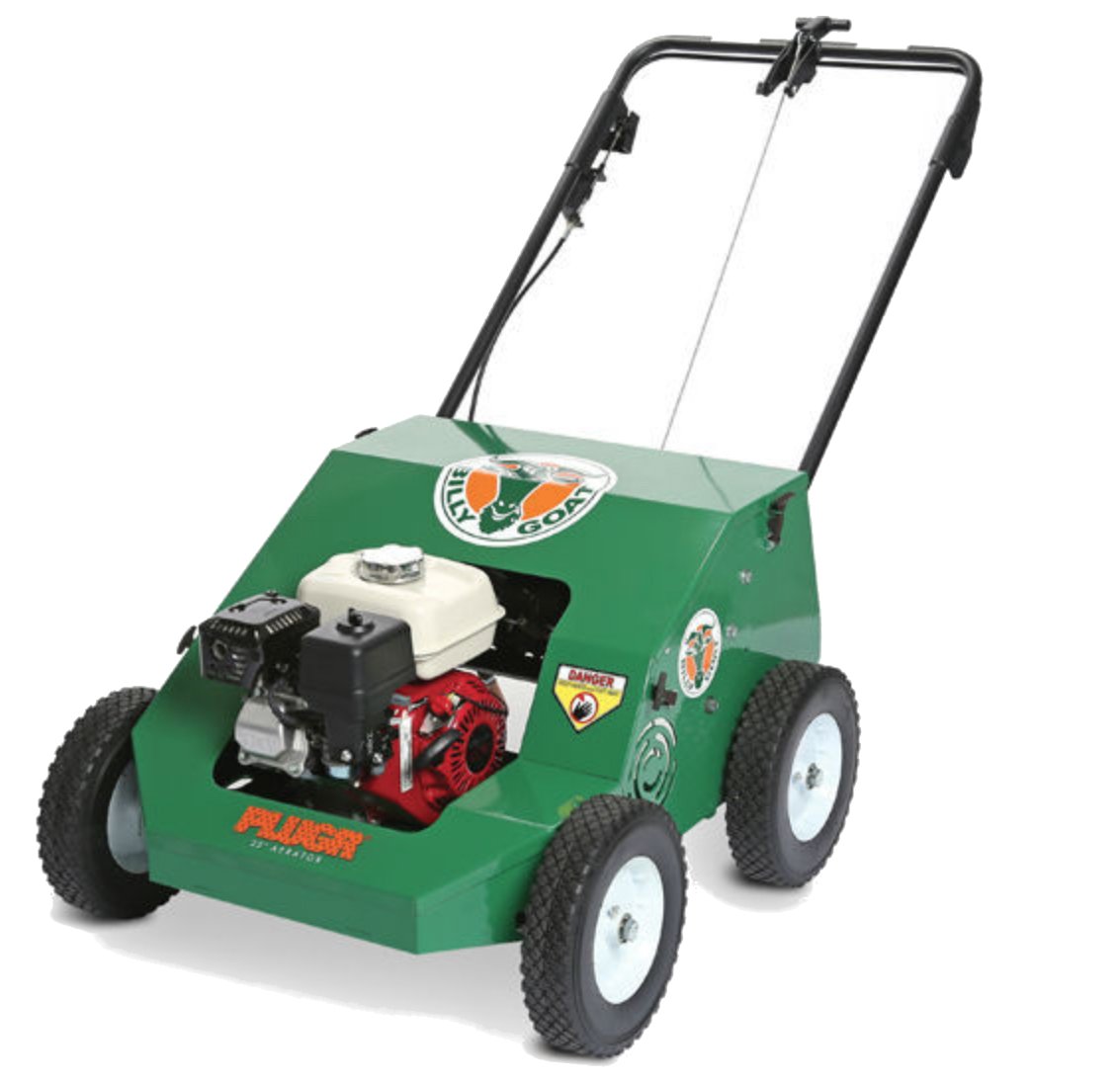Do I Need a Lawn Aerator?
Billy Goat Plug Aerator (Honda engine)
Next time you are in your garden, take a good look at your lawn. Is it green? Is it lush? How does it feel? Springy? Firm? Does it seem healthy? Are you sure?
Whatever you feel about your lawn, there are often issues hiding around the corner that you haven’t even considered.
Thatch building up under the surface, soil that has not been irrigated properly, maybe ground that has become compacted and impenetrable.
Your lawn will thank you for doing something about this. Just a run over with the old mower every couple of weeks isn’t enough if you want a lawn you can be really proud of.
This is why more and more people who want a good, healthy lawn are investing in extra lawn care equipment like aerators and scarifiers.
In this article, we will be dealing exclusively with aerators, but there are articles on scarifying elsewhere in this knowledge base.
Thatch and weeds and moss built up in the lawn stop water, oxygen and nutrients reaching the grass roots. Hard compacted soil will do much the same, preventing the lawn from being fed and watered and affecting its health and colour.
How To Identify Lawn Problems Where Aeration May Help
1/ Compaction
The easiest of these issues to work out is probably soil compaction. This is very common. All lawns will be compacted to some degree.
Lawns are walked on played on, rolled on, have wheelbarrows wheeled over them. footballs kicked all over them and are generally part of your outdoor space so, like a carpet they need some TLC from time to time.

Compaction 1 – Lawn 0
Gardens with heavy clay soils are more prone to compaction and therefore are will probably have some issues with water retention and drainage.
So test your soil. If it is heavy clay soil then it is highly likely that your lawn will benefit from aeration. If your garden has medium to heavy traffic, it will probably benefit from aeration.
2/ Water Run-off
If you have any steepish slopes as part of your lawn this can be a problem. Sloped lawns are hard to keep irrigated as the water can often run away, reducing the amount that gets to the roots of the grass plants.
3/ Thatch
If your lawn feels over springy, spongy or has brown patches that are not linked with lack of rain or watering, there is a good chance you have an excessive build up of thatch.
You can check this by extracting a sample down to soil level a few inches down. If there is more than a centimetre to a centimetre and a half of organic material under the grass this could be a problem.
So. To recap, slopes, compaction and a build up of unwanted organic material and thatch can all affect your lawns health, blocking nutrients and reducing water and oxygen intake. Look for symptoms of the lawn drying out and
Aeration can help solve these problems, letting the lawn ‘breathe’ again and helping more water and nutrients get into the soil and grass roots, making them stronger, longer and more likely to flourish so your lawn looks, feels and is healthier.
Tip: Try sticking a pencil or similar into the soil. If it is a struggle to penetrate, this is a sign that there may well be compaction or a proliferation of thatch.
Other Symptoms
Water collecting, or puddling, on your lawn may well mean drainage issues which could be solved by aeration. Lawns may dry out as a result of thatch taking the majority of the water so patches of thinning or undeveloped grass may mean thatch or compaction.
Is Aeration The Answer?
Aeration can help solve these problems, letting the lawn ‘breathe’ again and helping more water and nutrients get into the soil and grass roots, making them stronger, longer and more likely to flourish so your lawn looks, feels and is healthier and more robust. It is easy to carry out and well worth the effort.
So What Precisely Is Aeration?
Aeration is the process of opening up the turf across the lawn, making holes at regular intervals that loosen compacted soil, cuts through thatch and allows the air and water in.
How Do I Aerate?
You can walk over the lawn with a fork and create holes, but regulating the holes and obtaining full coverage is tough, particularly if your lawn is expansive or you have several lawns. It also takes a fair amount of time and physical effort
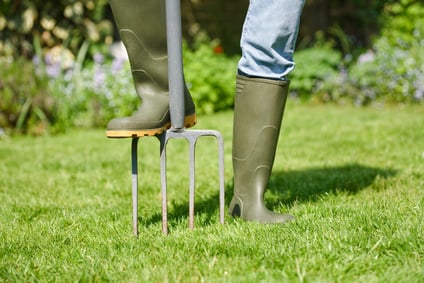
Aeration the hard way
How Else Can I Do It?
More and more gardeners and lawn enthusiasts are using wheeled, mechanical aerators, which use metal tines, or blades, usually revolving on a spool to create small, regular holes into the lawn.
What Aerators Are There on The Market?
Aerators come in all shapes and sizes. Hand propelled, self-propelled, towed, battery-powered, petrol powered or mains electric powered and can even be towed behind a lawn tractor.
Do They All Work The Same Way?
Not quite. They are, loosely, broken into two types:
Solid Tine Aerators
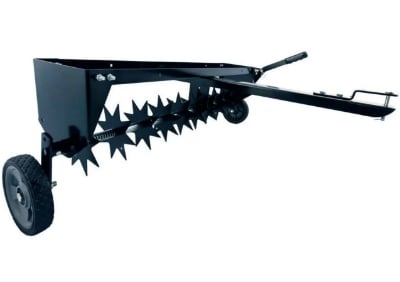
Agri-Fab Towed Solid Tine Aerator
This type of aerator is very straightforward. The solid tines cut or punch into the turf and soil and make a hole to let the water, nutrients and air in.
Solid tine aerators can also be broken down into two – spike or slit aerators, depending on the shape of the tines. Slit aerators use tines that are more like curved knives and generally penetrate deeper into the turf, cutting more into the roots.
Hollow Tine Aerators
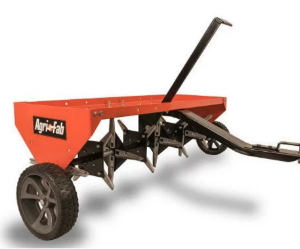
Agri-Fab Towed hollow Tine Aerator
A hollow tine aerator, by nature of the tines being sharpened hollow tubes, automatically remove ‘plugs’ of soil and thatch and grass lifted as the tines come out, out creating larger holes with less chance of collapse and more space for water and air to permeate.
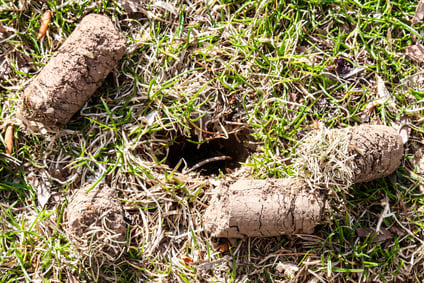
Close up of hollow tine aeration soil/thatch plugs
Solid v Hollow. Pros and Cons
If you are on a budget, you may well find that solid tine aerators are, in general, priced a little lower than the hollow tine variety. They are easy to use, probably easier than hollow tine aerators as they don’t need to punch as deep and need less weight or power to penetrate the turf.
That being said, solid tine aerators are sometimes seen as a more temporary fix and you will probably have to use one more than you would a hollow tine aerator. Many people, however, get by perfectly well with a basic, good quality, solid tine aerator.
hollow tine aerators are more likely to remove thatch, or at least will probably remove more, whereas a solid tine aerator does not.They are more likely to be effective than the solid tine models when soil compaction is serious or thatch out of control.
Hollow tine aerators operate at their optimum efficiency on moist ground, and will remove more soil and material in the plug.
What Do I Do With The Soil Plugs From A Hollow Tine Aerator?
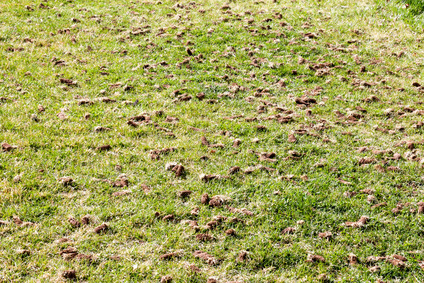
Hollow tine aeration plugs on a lawn
it is up to you. Some people like to leave them lying on the lawn, believing they are useful as natural fertiliser or mulch but other schools of thought see leaving them there them as not just messy and unattractive, but as a potential harbinger of weeds and more thatch.
So leave them, rake them, put them on your compost heap, trial and error will soon show you what is best, but if you like a clean and tidy lawn, get rid of them straight away.
We have a good range of aerators of all types and you can see all of them here. or if you need more advice, why not call us on 0345 4588 905 (9am-5pm Mon-Fri – 10am-4pm Sat) our friendly, knowledgeable product advisors can help you choose the machine that is right for you.
“…extremely helpful and knowledgeable customer service…” Mark (TRUSTPILOT)
